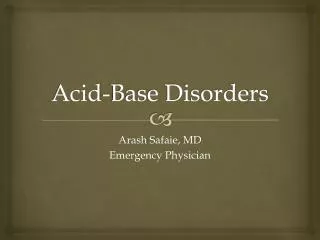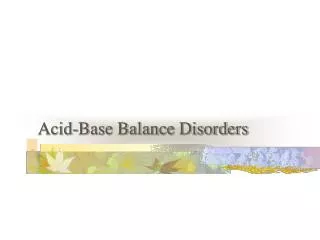

ostinmannual + Follow
Download PresentationAn Image/Link below is provided (as is) to download presentation Download Policy: Content on the Website is provided to you AS IS for your information and personal use and may not be sold / licensed / shared on other websites without getting consent from its author. Content is provided to you AS IS for your information and personal use only. Download presentation by click this link. While downloading, if for some reason you are not able to download a presentation, the publisher may have deleted the file from their server. During download, if you can't get a presentation, the file might be deleted by the publisher.

Acid-Base Disorders. Sharon Anderson, M.D. Division of Nephrology and Hypertension May 2003. General Acid-Base Relationships. Henderson-Hasselbach equation: pH = pK + log HCO 3 _ /pCO 2 H + = 24 x pCO 2 /HCO 3 _ 0.1 pH unit = 10 nm/L H +. Approach to Acid-Base Disorders.
2.14k views • 59 slides

ACID-BASE DISORDERSGoals and Objectives:1) Be able to define the primary acid-base disorders.2) Be able to interpret an arterial blood gas.3) Know the common causes of various acid-base disorders.4) Be able to calculate the anion gap and understand ??its use in determining the causes
630 views • 32 slides

. The material in these slides is not original - it represents a collage taken from several sources. Alkaline creatures in an acidic environment. Although we produce acids we have been designed to be alkaline creatures . Principles of Acid-base balance interpretation. Acid can be defined as a p
1.3k views • 85 slides

ACID-BASE DISORDERS. dr. Husnil Kadri, M.Kes Biochemistry Departement Medical Faculty Of Andalas University Padang. Normal values for arterial blood gases. Arterial Blood Gases (ABG). Normal values may differ slightly in exams. * Indicates measured parameter.
376 views • 28 slides

Acid-Base Disorders. Arash Safaie , MD Emergency Physician. Basic Concepts. pH ↓7.36: Acidemia ↑7.44: Alkalemia Physiologic Buffers Bicarbonate Carbonic Acid Systems (RBCs) Phosphate Buffers (Bone). Useful Knowledge. ABG vs. VBG. Role of Temperature. VBG pH: 0.03↓ PCO2: 6.6↑
1.15k views • 20 slides

ACID/BASE DISORDERS. Resident Rounds Rob Hall PGY3 April 24, 2003. Objectives. Approach to A/B disorders Clinical examples of each disorder Differential dx of each disorder Combined disorders. Should we even do ABGs?.
536 views • 27 slides

ACID-BASE DISORDERS. I.M.SIALA, MD. Acid-base disorders. Blood Pressure. Pulse. Proper Cell Function. Temperature. Hemoglobin. Ca, K, …. Hydrogen Ion Concentration. NORMAL RANGE. Hydrogen Ion Concentration. may change out of the normal range:
686 views • 42 slides

Acid-base Disorders. Dr Michael Murphy FRCP Edin FRCPath Senior Lecturer in Biochemical Medicine. Outline of lecture. Basic concepts Definitions Respiratory problems Metabolic problems How to interpret blood gases. Questions. What is being regulated? Why the need for regulation?
934 views • 42 slides

Disorders of acid base balance. Gamal El Naggar Internal Medicine Department Tanta Faculty of Medicine Nephrology Unit. by. Acid-base disorders.
591 views • 21 slides

Acid-Base Disorders. Charles J. Foulks, MD, FACP Professor of Medicine School of Community Medicine. [H + ] Metabolism. Origin of H + : fats, CHO 15-20 mol of CO 2 per day produced Volatile acid Protein: S, N, P containing amino acids Fixed acid Must buffer and then excrete H +
857 views • 45 slides

Acid-Base Disorders. Robert Fields, DO St Joseph’s Mercy Hospital Emergency Dept. 5 Steps is all you need. Check the pH Find the primary disorder (Look at pCO2 and HCO3) Calculate the anion gap (AG=Na – (HCO3 + Cl-) Calculate the excess anion gap (AGp - AGn + HCO3p = X)
757 views • 45 slides

Chapter 4 Acid-base balance and acid-base disorders. Department of Pathophysiology, the School of Medicine, Shandong University 薛冰. internal environment homeostasis. Water balance. homeostasis. electrolyte balance. acid-base balance. Contents. 1. Acid-Base Balance
2.68k views • 152 slides

ACID BASE BALANCE and Disorders. Acids :. Are any substance which tends to release H+ in water , either by simple dissociation or reaction
423 views • 21 slides

Acid-Base Balance Disorders. H + concentration (activity) in arterial blood 40 ± 4 nmol/l (or 4*10 -8 mol/l, or 0,00000004 mol/l) Sörensen (1909) pH = -log [H + ] ( pH – negative logarithm of [ H + ] ) [ H + ] = 40 nmol/l = 40.10 -9 mol/l = 4.10 -8 mol/l
597 views • 27 slides

ACID – BASE DISORDERS. Prof. M. Tatár Dept. of Pathophysiology JLF UK. H + affects structure and function of proteins. . changes of cellular enzymes activity. . cellular and organ functions changes.
473 views • 26 slides

Disorders of acid base balance. Gamal El Naggar Internal Medicine Department Tanta Faculty of Medicine Nephrology Unit. by. Respiratory alkalosis. Causes (hyperventilation CO2 wash)
400 views • 23 slides

Acid – Base Disorders. Viyeka Sethi PGY 4 Med-Peds. Four Main Acid-Base Disorders. Normal Values. Step by Step. Determine the primary disturbance: Acidemia or Alkalemia: look at the pH < 7.40 = acidemia > 7.40 = alkalemia Respiratory or Metabolic: look at HCO3 and CO2
484 views • 16 slides

F. Rashid Farokhi Nephrologist Masih Daneshvari Hospital. ACID base disorders. - 6. - 9. Extra cellular fluid H+ concentration [H +] = 40 10 meq/lit = 40 10 Eq/lit PH = - log [H+] PH = 7.35 - 7.45. meq. - 7. 7.4. 7.35. 7.45. 6.8. 7.8.
929 views • 66 slides

Approach to Acid-Base Disorders. Antonio Renato B. Herradura, M.D. F.P.C.P, F.P.C.C.P UERMMMC. Importance of Acid-Base Disorders. Among the most common clinical problems encountered in hospitalized patients, especially ICU patients Lead to significant physiologic effects
858 views • 33 slides

Acid - Base Disorders. Close regulation of PH is necessary for cellular enzymes and other metabolic processes,which function optimally at a normal PH (7.35 to 7.45).
515 views • 42 slides

ACID – BASE DISORDERS. M. Tatár. H + affects structure and function of proteins. . changes of cellular enzymes activity. . cellular and organ functions changes. Sources of H + in organism. a) Volatile acid CO 2 + H 2 O H 2 CO 3 H + + HCO 3 -. b) fixed acids
262 views • 22 slides

ACID BASE DISORDERS. It aiN’T All that Simple Dr alex Hieatt Consultant ED. What is an ABG?. The Components pH / PaCO 2 / PaO 2 / HCO 3 / O 2 sat / BE Desired Ranges pH - 7.35 - 7.45 PaCO 2 – 4.5 – 6 kPa PaO 2 – 10.5 – 13.5 kPa HCO 3 - 21-27 O 2 sat - 95-100%
647 views • 26 slides